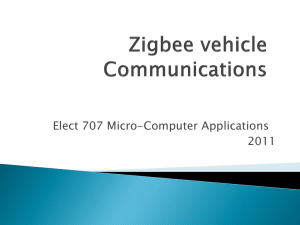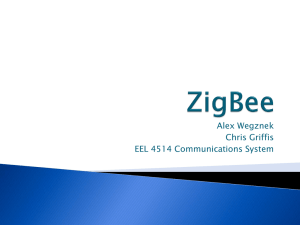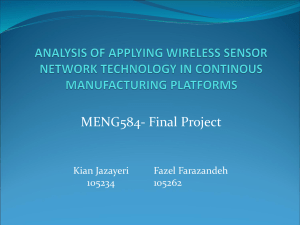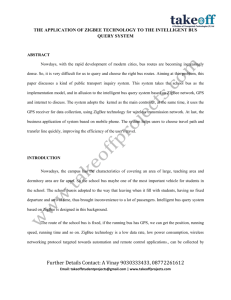Abstract – Notice Boards are a common occurrence in
advertisement
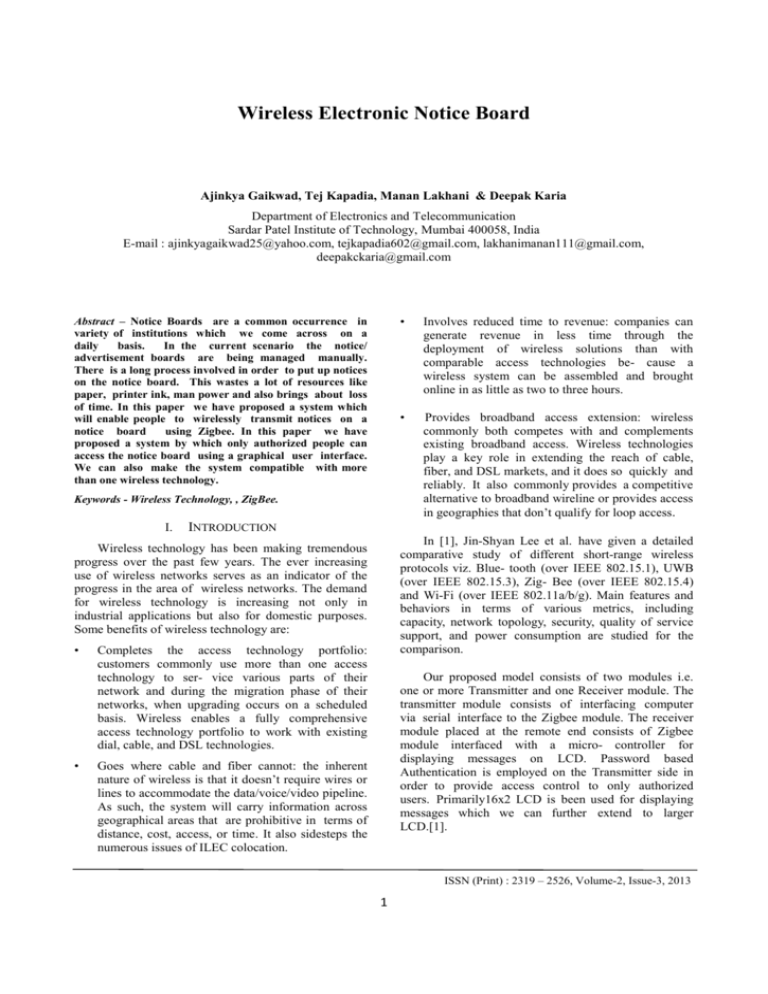
Wireless Electronic Notice Board Ajinkya Gaikwad, Tej Kapadia, Manan Lakhani & Deepak Karia Department of Electronics and Telecommunication Sardar Patel Institute of Technology, Mumbai 400058, India E-mail : ajinkyagaikwad25@yahoo.com, tejkapadia602@gmail.com, lakhanimanan111@gmail.com, deepakckaria@gmail.com Abstract – Notice Boards are a common occurrence in variety of institutions which we come across on a daily basis. In the current scenario the notice/ advertisement boards are being managed manually. There is a long process involved in order to put up notices on the notice board. This wastes a lot of resources like paper, printer ink, man power and also brings about loss of time. In this paper we have proposed a system which will enable people to wirelessly transmit notices on a notice board using Zigbee. In this paper we have proposed a system by which only authorized people can access the notice board using a graphical user interface. We can also make the system compatible with more than one wireless technology. Keywords - Wireless Technology, , ZigBee. I. • Involves reduced time to revenue: companies can generate revenue in less time through the deployment of wireless solutions than with comparable access technologies be- cause a wireless system can be assembled and brought online in as little as two to three hours. • Provides broadband access extension: wireless commonly both competes with and complements existing broadband access. Wireless technologies play a key role in extending the reach of cable, fiber, and DSL markets, and it does so quickly and reliably. It also commonly provides a competitive alternative to broadband wireline or provides access in geographies that don’t qualify for loop access. INTRODUCTION In [1], Jin-Shyan Lee et al. have given a detailed comparative study of different short-range wireless protocols viz. Blue- tooth (over IEEE 802.15.1), UWB (over IEEE 802.15.3), Zig- Bee (over IEEE 802.15.4) and Wi-Fi (over IEEE 802.11a/b/g). Main features and behaviors in terms of various metrics, including capacity, network topology, security, quality of service support, and power consumption are studied for the comparison. Wireless technology has been making tremendous progress over the past few years. The ever increasing use of wireless networks serves as an indicator of the progress in the area of wireless networks. The demand for wireless technology is increasing not only in industrial applications but also for domestic purposes. Some benefits of wireless technology are: • • Completes the access technology portfolio: customers commonly use more than one access technology to ser- vice various parts of their network and during the migration phase of their networks, when upgrading occurs on a scheduled basis. Wireless enables a fully comprehensive access technology portfolio to work with existing dial, cable, and DSL technologies. Our proposed model consists of two modules i.e. one or more Transmitter and one Receiver module. The transmitter module consists of interfacing computer via serial interface to the Zigbee module. The receiver module placed at the remote end consists of Zigbee module interfaced with a micro- controller for displaying messages on LCD. Password based Authentication is employed on the Transmitter side in order to provide access control to only authorized users. Primarily16x2 LCD is been used for displaying messages which we can further extend to larger LCD.[1]. Goes where cable and fiber cannot: the inherent nature of wireless is that it doesn’t require wires or lines to accommodate the data/voice/video pipeline. As such, the system will carry information across geographical areas that are prohibitive in terms of distance, cost, access, or time. It also sidesteps the numerous issues of ILEC colocation. ISSN (Print) : 2319 – 2526, Volume-2, Issue-3, 2013 1 International Journal on Advanced Computer Theory and Engineering (IJACTE) II. COMPARATIVE STUDY The power consumption of Bluetooth and ZigBee is much less than Wi-Fi. Along with low power consumption and the possibility to increase the range of deployment, the network scalability offered by ZigBee is large as compared to Bluetooth [2]. The comparison of above parameters leads us to select ZigBee as the wireless interface technology for our proposed system Table I below summarizes [4] [1] the key differences between the three short-range wireless technologies. As shown below, Wi-Fi provides higher data rates for multimedia access as compared to both ZigBee and Bluetooth which provides lower data transfer rates. ZigBee and Bluetooth are intended for WPAN communication (about 10m), while Wi-Fi is de- signed for WLAN (about 100m). Although certain ZigBee chipsets can reach a range of upto 100m. III. ZIGBEE PROTOCOL ZigBee is a specification for a suite of high level communication protocols using small, low-power digital radios based on an IEEE 802 standard for personal area networks. [5] ZigBee devices are often used in mesh network form to transmit data over longer distances, passing data through intermediate devices to reach more distant ones. This allows ZigBee networks to be formed ad-hoc, with no centralized control or high-power transmitter/receiver able to reach all of the devices. Any ZigBee device can be tasked with running the network. TABLE I COMPARISON OF THE BLUETOOTH, ZIGBEE, AND WI-FI PROTOCOLS Standard Application Focus Frequency band Max signal rate Bluetooth Cable Replacement 2.4 GHz Nominal range Channel bandwidth Data protection Max number of cell nodes 1 Mb/s ZigBee Monitoring and Control 868/915 MHz; 2.4 GHz 250 Kb/s Wi-Fi Web, Email, Video 2.4 GHz; 5GHz 54 Mb/s 10 m 10 - 100 m 100 m 1 MHz 0.3/0.6 MHz; 2 MHz 16-bit CRC 22 MHz 16-bit CRC 8 more than 65000 ZigBee is targeted at applications that require a low data rate, long battery life, and secure networking. ZigBee has a defined rate of 250 kbit/s, best suited for periodic or intermittent data or a single signal transmission from a sensor or input device. Applications include wireless light switches, electrical meters with inhome-displays, traffic management systems, and other consumer and industrial equipment that requires shortrange wireless transfer of data at relatively low rates. The technology defined by the ZigBee specification is intended to be simpler and less expensive than other WPANs, such as Bluetooth or Wi-Fi. 32-bit CRC 32 Table II below provides the comparison of the electrical parameters for the different chipsets of BlueCore2 [1] from Cambridge Silicon Radio (CSR), XB24-B [4] from Digi International Inc. and CX53111 [2] from Conexant (previous Intersils Prism), while Fig. 2 indicates power consumption in mW unit for each protocol. ZigBee devices are of three types: • ZigBee Co-ordinator (ZC): The most capable device, the Co-ordinator forms the root of the network tree and might bridge to other networks. There is exactly one ZigBee Co-ordinator in each network since it is the device that started the network originally (the ZigBee LightLink specification also allows operation without a ZigBee Co-ordinator, making it more usable for over- the-shelf home products). It stores information about the network, including acting as the Trust Center repository for security keys. ZigBee Router (ZR): As well as running an application function, a Router can act as an intermediate router, passing on data from other devices. • ZigBee End Device (ZED): Contains just enough functionality to talk to the parent node (either the Co-ordinator or a Router); it cannot relay data from other devices. This relationship allows the node to TABLE II CURRENT CONSUMPTION OF CHIPSETS FOR EACH PROTOCOL Standard Bluetooth ZigBee Wi-Fi Chipset BlueCore2 XB24-B CX5311 VDD (volt) 1.8 3.3 3.3 TX (mA) 57 40 219 RX (mA) 47 40 215 Nominal TX power (dBm) 0 to 10 -25 to 0 15 to 20 1-7 100 - 1000 0.5 - 5 Battery Life (days) ISSN (Print) : 2319 – 2526, Volume-2, Issue-3, 2013 2 International Journal on Advanced Computer Theory and Engineering (IJACTE) be asleep a significant amount of the time thereby giving long battery life. A ZED requires the least amount of memory, and therefore can be less expensive to manufacture than a ZR or ZC. [6] A. Transmitter section Fig. 3. Fig. 1. Block diagram of Transmitter Transmitter Section mainly consists of serial port interfaced to Zigbee Module via MAX232. Module of XBEE Series2 of Digi Inc. [4] has been used. The Xbee radios are programmed using X-CTU software in API mode with the desired baud rate. Screenshots of X-CTU are shown in Fig. 6. A .Net based GUI application is developed on PC which enables the user to display message. The application authenticates user and then allows to display message. Zigbee devices IV. SYSTEM DESIGN The proposed system consists of Transmitter section and Receiver section. The complete schematic is as shown: Fig. 4. Fig. 5. Fig. 2. Schematic X-CTU Voltage Regulator ISSN (Print) : 2319 – 2526, Volume-2, Issue-3, 2013 3 International Journal on Advanced Computer Theory and Engineering (IJACTE) A voltage regulator is designed to automatically maintain a constant voltage level. It is used to stabilize the DC voltages used by the processor and other elements. It is used in the Transmitter section to stabilize the voltage at the output of MAX232 before passing it to Zigbee Module. VII. ACKNOW LEDGMENT We would like to thank our mentor and guide Dr. D. C. Karia for guidance and help throughout our project. We are also thankful to our Institute Sardar Patel Institute of Technology, Mumbai, India for providing all the facilities needed for our project. B. Receiver section Fig. 6. VIII. REFERENCES Receiver section Zigbee module on the receiver side is interfaced with UART(Universal Asynchronous Receiver/ Transmitter) of Micro-Controller PIC16F877A. Micro-Controller receives the message from Zigbee module on receiver side and displays it on the LCD screen. It also provides Synchronization between Transmitter and Receiver. V. FUTURE SCOPE Electronic Notice Board is one of the application where Zigbee can be used effectively. It can also be used in Malls and Highways for Advertisement purpose. A moving display with variable speed can also be used in place of static display. [1] J. S. Lee, Y. W. Su, and C. C. Shen, ”A Comparative Study of Wireless Protocols: Bluetooth, UWB, ZigBee, and Wi-Fi”, Proceedings of the 33rd Annual Conference of the IEEE Industrial Electronics Society (IECON), pp. 46-51, November 2007. [2] E. Ferro and F. Potorti, ”Bluetooth and Wi-Fi wireless protocols: a survey and a comparison”, Wireless Communications, IEEE, vol. 12, no. 1, pp.12-26, February 2005. [3] J. S. Lee, ”Performance Evaluation of IEEE 802.15.4 for Low-Rate Wireless Personal Area Networks”, IEEE Transactions on Consumer Electronics, vol. 52, no. 3, pp. 742-749 , August 2006. [4] ”XBee Series 2 OEM RF Modules Product Manual”, Digi International, Inc., June 2007. [5] J. S. Lee and Y. C. Huang, ”ITRI ZBnode: A ZigBee/IEEE 802.15.4 Plat- form for Wireless Sensor Networks”, Proceedings of IEEE International Conference on Systems, Man, and Cybernetics, Taipei, Taiwan, vol. 2, pp. 14621467, October 2006 [6] Safaric, S.; Malaric, K;Zigbee Wireless Standard , IEEE International conference on Multimedia Processing and Communications, March 2006. VI. CONCLUSION Wireless operations permit services, such as longrange communications, that are impossible or impractical to implement with the use of wires. It provides fast transfer of information and are cheaper to install and maintain. This paper provides an efficient way of displaying messages on Notice Board using Wireless Technology. It also provides user authentication in order to avoid any misuse of proposed system. ISSN (Print) : 2319 – 2526, Volume-2, Issue-3, 2013 4

